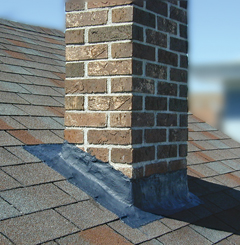flashing

Hoover Dam.
Flashing is a method of sealing joints on buildings, especially around roofs, chimneys, gutters, and valleys, in order to render them water-tight. It consists of using strips, or shingles, of flashing material which are worked into the normal roof surface and turned over the joint. Where the flashing turns up, as along a brick wall, it is necessary to counter-flash, that is to let a strip of flashing material into the brickwork and bend it down over the other flashing. A sloped shingle roof flashed against a brick wall requires flashing shingles which are worked under the top course of the regular shingles and turned up along the bricks. Corresponding counter-flashing let into the brick is bent down over these flashing shingles. A joint between the gutter and cornice is made weather-proof by flashing. Usually the flashing extends from under the lowermost course of shingles and is turned down over the edge of the gutter. The most common flashing materials are tin-coated sheet iron and copper. Lead and zinc are used to a limited extent.
